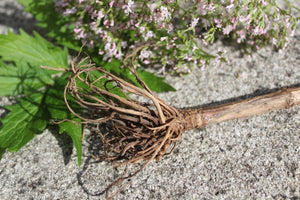Cold Stratification: The Secret to Why Your Seeds Aren't Sprouting
Starting seedsIt's frustrating when you plant a packet of seeds and after watching and waiting for days, only a few seeds sprout.
What happened?
Is something wrong?
Did you get bad seeds?
You may have done everything right, but it could be that these particular seeds need a little extra help to know when it's time to start growing.

Maximize your seed germination rates.
Cold stratification is the secret to maximizing your seed germination rates.
This process happens naturally in the winter but can easily be replicated indoors.
We'll explain how to mimic Mother Nature so you can give your seeds the best start possible and enjoy a plentiful harvest.
What is cold stratification?
Also called cold stratifying and seed stratification, cold stratification is a process of exposing seeds to cold temperatures in order to stimulate germination. This is a natural process that seeds go through in the winter. That is why some seeds are planted in the fall.
But even if you don't plant in the fall, or you live in an area that doesn't get cold winters, you can still mimic nature.
Why do some seeds require cold stratification?
Many plants require a cold period to break their dormancy. This is especially true for perennial plants, which are adapted to survive the winter season. Before they can germinate, these types of seeds must experience a period of cold temperatures that mimic the onset of winter. The cold temperature lets the seed know that it's not time to grow
During this cold, moist period, the seed's hard outer shell is softened. Also, the cell walls and dormancy mechanism will be broken down, allowing the seeds to germinate successfully when the warmer temperatures arrive.
Without cold stratification, some seeds may remain dormant and never germinate. In other words, cold stratification gives your seeds a jump start on the growth process!

Supplies for cold stratification
The supplies needed for cold stratification are simple.
Refrigerator
Plastic zip-top bag
Spray bottle with water
Paper towel
Seeds
How to cold stratify your seeds
- Start by soaking the seeds for 12 to 24 hours.
- Then take a paper towel and throughly spray it with water.
- Sprinkle 1/2 of the paper towel with seeds.
- Then fold the paper towel over.
- Press the paper towel onto the seeds so that it makes contact to keep the seeds moist.
- Then place the paper towel in a plastic bag and zip it shut.
- Label the bag with the seed variety and date.
- Then place the bag in the fridge.
- Leave it in the fridge for 3 to 4 weeks.
After the cold period, the seeds are ready to plant.

What are the benefits of cold stratifying seeds?
- Using cold stratification can significantly increase your seed germination rates.
- In our tests, we found almost a 100% germination rate for our lavender seeds when we used cold stratification before sowing indoors.
- Cold stratifying allows you to start seeds any time of year.
- You don't have to wait for winter to plant lavender, catnip, and other seeds that need a cold spell. Use the refrigerator to mimic nature.
Watch our video on how to cold stratify lavender seeds for maximum seed germination!
What are some seed varieties that require cold stratification?
Many seed varieties, such as conifers, perennial flowers, and shrubs, require cold stratification in order to break their dormancy. Additionally, some annuals, like morning glory and columbine, will benefit from cold stratification if they are planted in warm climates or during the summer months. It is important to understand the specific requirements of the seed variety you are planting so that you can give it the best start possible. For example, some seeds may require a longer period of cold than others.
List of Seeds That Need Cold Stratification

Should I cold stratify in the fridge or freezer?
How cold do the seeds need to be? A refrigerator is an ideal place to keep seeds for cold stratification. It keeps seeds below 40º since home refrigerators should be between 35º and 38º. In our germination tests with lavender, we had excellent results when we placed seeds in the door of the refrigerator for 4 weeks.
Alternatives to cold stratification
Don't have access to a fridge? Or want to try something else?
Another way to naturally cold stratify seeds is to do winter sowing. This gets your seeds out in the cold weather so they get the cold period they need to germinate. You can learn more about winter sowing here.
Cold stratification is a vital seed-starting technique that can make a huge difference in your seed germination rate.
Starting seeds doesn't have to be frustrating. Knowing which seeds benefit from cold stratification will help you be a more successful gardener.
Happy Growing!
Popular Posts
-

Chicory Root: The Herb for Healthy Roasting and Brewing
-

How to Grow Valerian Root from Seed to Harvest






Leave a comment